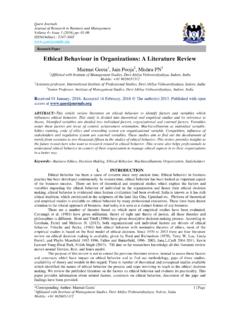Transcription of A literature review of aspects of the Primary Curriculum ...
1 A literature review of aspects of the Primary Curriculum produced by curee1 Part 1 1 The Centre for the Use of Research and Evidence in Education Following our initial response to the call for evidence for the independent review of the Primary Curriculum , CUREE was asked by QCA to use its knowledge of the evidence base to bring together supplementary information which would inform the review in more detail. Specifically QCA requested further evidence as it relates to Primary education with regard to: 1. An accessible definition of scaffolding . 2. Empirical evidence related to Vygotsky s learning theory. 3. Developing thinking skills. 4. How intense skills development and knowledge acquisition sits alongside Bruner s model of the spiral Curriculum : using iterative and gradually cumulative approaches to encountering and making ever deeper sense of big ideas.
2 5. Approaches to student learning styles. 6. Taking new practice to scale. 7. Breakthroughs in mathematics teaching and learning. 8. The value of ICT in teaching and learning. 9. The maturity of the evidence base (where there is robust evidence for particular approaches, and where the gaps are). 10. Finding the optimum balance between a focus on knowledge, skills and understanding. 11. Soft, social , and personal learning skills. This paper deals with items 1-6. A second paper, dealing with items 7-11 is available in a separate briefing. We have taken a layered approach to identifying evidence sources in order to be as comprehensive as possible within the timescale: trawling our existing database of studies scanning summaries of research that have been appraised for robustness for CPD products such as Research of the Month and TRIPS digests conducting specific keyword searches using education-specific databases such as ERIC and BEI.
3 Where we have drawn on evidence already summarised in Research of the Month and TRIPS digests, the sources will have already been rigorously appraised in terms of the robustness of the research approach taken and the reliability and validity of the findings, including for an English audience. In the case of Research of the Month summaries, the completed appraisal framework for each study can be accessed on the summary webpage. Page 1 of 26 Contents 1 3 2 Evidence base in support of Vygotsky s theories of 5 3 Thinking 9 4 12 5 Learning 17 6 Going to 19 22 Research of the Month 22 The Research Informed Practice Site (TRIPS) 23 Other 23 Page 2 of 26 1 Scaffolding Many teachers now refer to their use of scaffolding to support their pupils learning.
4 But what is scaffolding? The following definition is based on descriptions of teacher support in five studies three on literacy teaching in Primary school (Wharton-McDonald et al, 1998; Taylor et al, 2000; Pressley et al, 2001) and two on assessment in Primary and secondary (Black & William, 1998; Black et al, 2003). The studies were included because they describe in some detail scaffolding linked to effective teaching, from which the above definition was extrapolated. Each study was fully appraised for Research of the Month summaries. Definition of scaffolding You can make it easier for pupils to reach their learning goals by splitting up big development goals or tasks into several, progressive stepping stones and providing support such as prompting questions or writing frames.
5 This process is called scaffolding and can be used for a variety of complex tasks, such as writing a story, or designing an experiment. But an important aspect of scaffolding is that it is removed once pupils can make progress without such support. For example, you give pupils fewer prompting questions as they gain experience of a task. You can also foster your pupils independence by explicitly teaching them how they can split big tasks up into smaller tasks for themselves. (GTC Research of the Month Summary Behaviour for learning: Engaging with research. Accessible at: ) Teachers referred to scaffolding , for example, in relation to splitting up a task into smaller ones; asking learners prompting questions; providing children with writing frames or other protocols, etc. The work of Lev Vygotsky is helpful in gaining a better understanding of what scaffolding is and the theory underpinning it.
6 Unlike other educationalists of his day, Vygotsky was convinced that what children can achieve, assisted by an adult, tells us more about their capacity to learn in the future than tests they tackle in isolation. (GTC Research of the Month summary social interaction as a means of constructing learning: the impact of Lev Vygotsky s ideas on teaching and learning. Accessible at: ) To describe this potential for further learning that he believed each child had, Vygotsky introduced the idea of the zone of proximal development (ZPD) . He described the ZPD as the difference between the level of actual development as measured by tests, particularly IQ tests which were becoming common in Vygotsky s day, and the level of potential development that a learner could reach in collaboration with an adult; in other words, a zone of shared thinking in which a child, assisted by an adult or more knowledgeable peer, can successfully realise a new stage of development.
7 While Vygotsky himself did not propose the notion of scaffolding, it is consistent with his ideas of learning through social interaction that aims to support development. As Vygotsky s observations about what a child can achieve when supported became more widely known, other practitioners began to develop ways of supporting children s learning in their ZPDs. The term scaffolding was first coined by Wood, Bruner and Ross (1976), who were probably influenced by Vygotsky s work, when they were Page 3 of 26 investigating how adults support children's learning. In the context of the ZPD, scaffolding is the structured learning environment the teacher creates to help the pupil develop and use the tools, skills and abilities they require to complete their learning. The teacher needs to choose the type and content of the scaffolding carefully.
8 There are dangers in making the scaffolding too cautious and limited to extend the pupils thinking. But there are also dangers in using it to offer too big a step and thus take the pupil into completely unknown territory: Scaffolding must begin from what is near to the student s experience and build to what is further from their experience. Likewise, at the beginning of a new task, the scaffolding should be concrete, external, and visible. Vygotskian theory suggests that learning proceeds from the concrete to the abstract. This is why math skills are learned from manipulatives, and fractions from pies and graphs. Eventually these concrete and external models can be internalised and used for abstract thought. (MyRead: Strategies for teaching reading in the middle years. Accessible at: ) The following case study illustrates what scaffolding looks like in practice: A low achieving group of 12 year olds were doing a mystery about the disappearance of a tribe of Amazonian Indians.
9 They had before them slips of paper which included information about: gold prospectors water pollution infectious diseases hunting practices, and poverty among the non-Indian population etc. Although the data on the cards offered quite a bit of introductory support, the group of four boys hadn t made much progress in solving the problem of why the tribe had disappeared. The teacher visited them and pulled out a data item about the tribe s water supply. She then asked them to find any other data items about water and left them to work alone. The teacher had diagnosed the group s weakness in being able to classify/group data and had pointed them towards what they needed to do next. (Case study 2 of the GTC Research of the Month summary Enquiry-based learning, cognitive acceleration and the spiral Curriculum .)
10 Accessible at: ) Page 4 of 26 2 Evidence base in support of Vygotsky s theories of learning Vygotsky s theories of learning are often used to justify approaches to teaching and learning without any direct reference to empirical evidence that supports the theory. QCA wanted to know if there is any research evidence that supports these theories. The Research of the Month (RoM) summary on Vygotsky provides an overview of his theories and goes some way to link contemporary evidence with them. It teases out and clusters Vygotsky s ideas in the following way: language in children s learning - Vygotsky believed strongly in the importance of the social and cultural features of children s learning. He regarded speech as a tool that developed in a social context and which became the vehicle for thought children s play - from his analysis of pre-school children s play Vygotsky concluded that not only does play fulfil children s emotional and physical needs, it provides a major stimulus to their cognitive development the part played by schools and teachers -Vygotsky viewed school instruction as a key factor in children s development, which was crucial to the development of specific forms of thinking the significance of the zone of proximal development for teaching and learning - the concept with which Vygotsky is most closely and famously associated is that of the zone of potential (or proximal) development - the ZPD.













